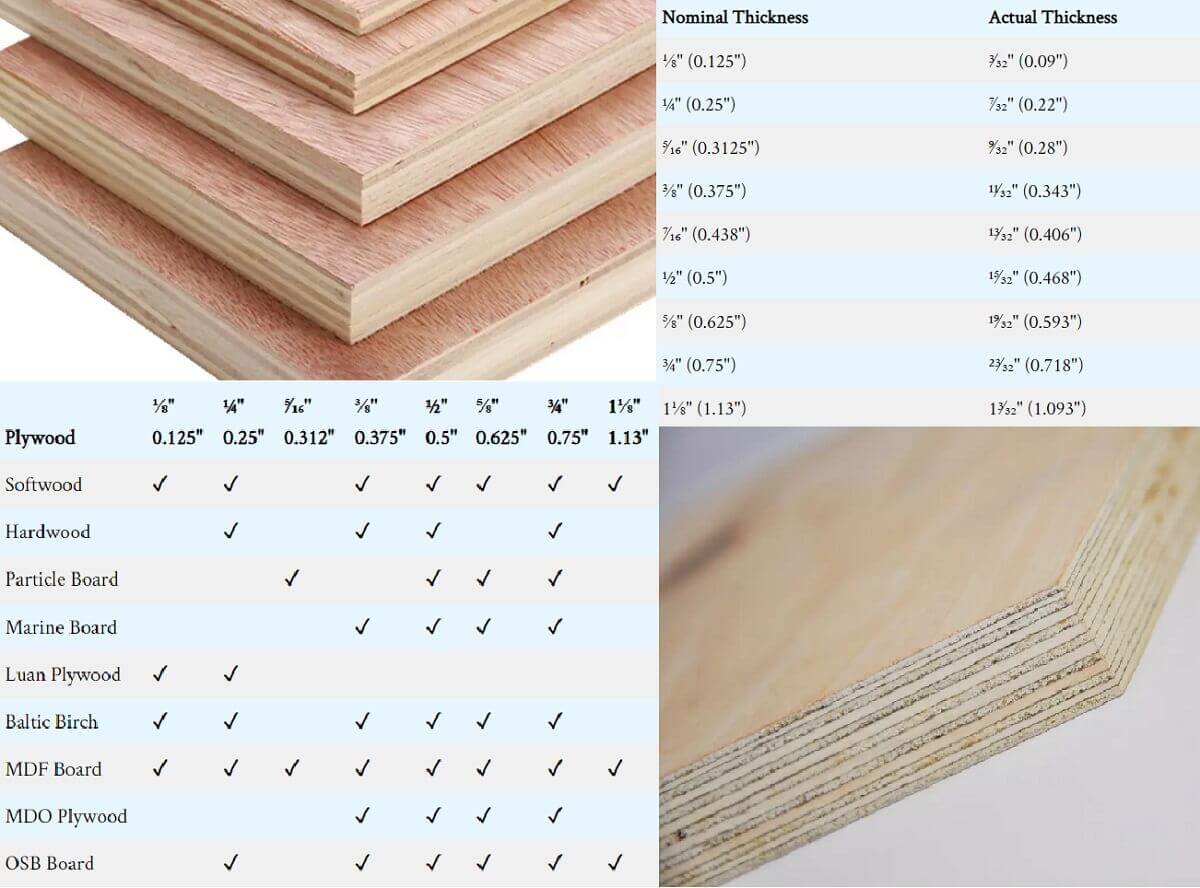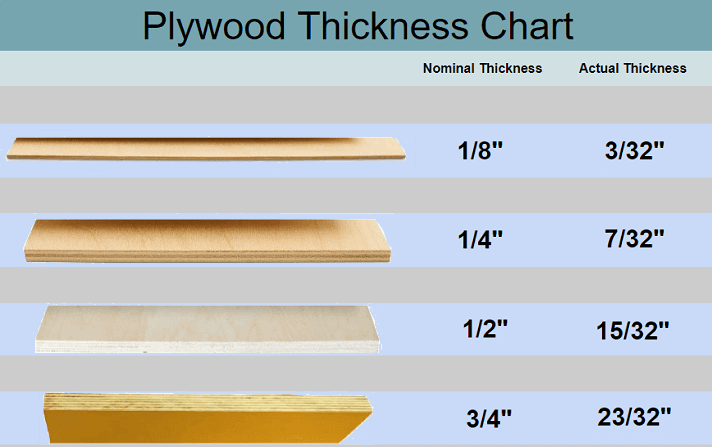Hey there, curious readers! Ever wondered if plywood comes in sizes bigger than 4×8? Well, you’re in the right place! Today, we’re diving into the fascinating world of plywood dimensions to answer your burning question. So, let’s jump right in and explore the possibilities together!
When it comes to plywood, the standard size you’ll often come across is 4×8 feet. But guess what? Plywood does come in larger sizes too! While 4×8 is the most commonly available dimension, you can find plywood sheets in various other sizes to suit different needs. Isn’t that cool? So, if you’re working on a project that requires larger panels, keep reading to discover what options you have.
You may be wondering, “What sizes are available beyond 4×8?” Well, my friend, plywood can come in dimensions like 5×10, 5×12, and even 5×14 feet! These larger sizes offer more versatility and can be beneficial for projects where you need wider or longer panels. Whether you’re building furniture, constructing walls, or working on a DIY masterpiece, knowing these options opens up a world of possibilities. So, let’s dive deeper into the world of bigger plywood sizes!

Does Plywood Come Bigger Than 4×8?
When it comes to plywood, one of the most commonly available sizes is 4 feet by 8 feet, also known as 4×8 plywood. This standard size has become widely popular due to its versatility and compatibility with various construction and woodworking projects. However, many individuals wonder if plywood comes in larger sizes, such as 6×8 or 5×10. In this article, we will explore the different sizes of plywood available on the market and discuss the options beyond the standard 4×8 dimensions.
Types of Larger Plywood Sizes
While 4×8 plywood is the industry standard, it’s worth mentioning that larger sizes are indeed available. These larger plywood sheets serve specific purposes, cater to unique projects, and offer various advantages. Let’s take a closer look at some of the larger plywood sizes:
1. 5×10 Plywood
One of the most common sizes larger than 4×8 is 5×10 plywood. This size is often used in larger-scale construction projects that require a more extensive coverage area. 5×10 plywood can be advantageous for reducing the number of joints required, improving stability, and minimizing the need for additional support. It is commonly used for applications such as flooring, roofing, and walls in commercial buildings or large residential structures.
One key benefit of 5×10 plywood is its ability to cover a larger surface area, which can help reduce installation time and labor costs. Additionally, the larger size allows for fewer seams, resulting in a cleaner and more aesthetically pleasing finished product. However, it’s important to note that 5×10 plywood may not be as readily available as the standard 4×8 sheets and may require special ordering or sourcing.
2. 6×8 Plywood
Another option for larger plywood sizes is 6×8 plywood. While less common than 4×8 or 5×10 sheets, 6×8 plywood is typically utilized in specialized applications that require specific dimensions. These larger sheets can be beneficial for reducing the number of joints, contributing to increased structural integrity, and providing improved stability and rigidity.
6×8 plywood is often used in applications such as industrial machinery, large-scale cabinetry, and construction projects that require durable and impact-resistant materials. However, due to their unique size, 6×8 plywood sheets may not be as readily available at standard retail locations and may require ordering directly from manufacturers or specialty suppliers.
3. Oversized Plywood
In addition to the aforementioned sizes, it is also possible to find plywood sheets that exceed the typical dimensions of 4×8, 5×10, or 6×8. These oversized plywood sheets are custom-made and can be tailored to suit specific project requirements. They offer maximum flexibility in terms of size and can be an excellent option for unique construction or woodworking projects.
Many manufacturers and suppliers offer custom fabrication services that can produce plywood sheets in sizes larger than the standard dimensions. These oversized plywood sheets are often used in applications such as boat building, large-scale formwork, and architectural projects that demand unique sizes and shapes. While oversized plywood may come at a higher cost and require longer lead times, they provide the opportunity to accommodate unconventional designs and dimensions.
Factors to Consider When Choosing Plywood Sizes
When deciding on the appropriate plywood size for a project, several factors should be taken into consideration:
1. Project Requirements
The nature of your project and its specific requirements will determine the optimal plywood size. Consider factors such as the surface area that needs to be covered, the structural demands of the project, and any design considerations. By understanding your project’s unique requirements, you can select the most suitable plywood size.
2. Accessibility
While larger plywood sizes may offer advantages in terms of stability and reduced seams or joints, it’s important to consider the accessibility of these sizes. Larger plywood sheets might not be as readily available at standard retail locations, and acquiring them may involve additional time, effort, or costs. Evaluate the availability of larger plywood sizes in your locality and determine if they align with your project timeline and budget.
3. Budget
Plywood prices vary based on factors such as size, grade, and type. Larger plywood sheets generally come at a higher cost due to their increased size and potential customization. Assess your project budget and determine if the use of larger plywood sizes aligns with your financial plan.
4. Handling and Installation
Consider the logistics of handling and installing larger plywood sheets. Larger sizes can be heavier and more challenging to maneuver during transportation and installation. Ensure that your team has the necessary equipment, resources, and expertise to handle and install larger plywood sizes safely and efficiently.
Conclusion
While the standard size for plywood is typically 4×8, larger sizes such as 5×10 and 6×8 are available and serve specific purposes in various construction and woodworking projects. It is important to consider the unique needs of your project when selecting the appropriate plywood size. Factors such as project requirements, accessibility, budget, and handling considerations should all be taken into account. By understanding the advantages and limitations of larger plywood sizes, you can make an informed decision that aligns with your project goals.
Does Plywood Come Bigger Than 4×8?
Yes, plywood does come in larger sizes than 4×8 feet.
1. Larger plywood sheets can measure up to 5×10 feet.
2. These larger sizes are ideal for projects that require larger panels.
3. Bigger plywood sheets can be more difficult to transport and handle.
4. You may need special equipment or assistance to work with larger plywood sheets.
5. It’s important to check with your local suppliers for the availability of larger plywood sizes.
Frequently Asked Questions
Are there different sizes of plywood available? What should I know about the dimensions?
1. Can plywood come in sizes larger than 4×8?
Yes, plywood can come in sizes larger than 4×8. While 4×8 is a commonly available standard size, there are larger sizes produced for specific applications. These larger sizes are often used in commercial construction projects, furniture manufacturing, and other specialized industries. It’s important to note that larger plywood sizes may not be as widely stocked as the standard 4×8 sheets, so it’s recommended to check with suppliers or manufacturers for availability.
When using larger plywood sheets, it’s crucial to consider transportation and handling logistics, as they may require special equipment or additional manpower. Additionally, the larger sheets may have different thickness options available, so make sure to factor that into your project planning.
2. What are the benefits of using larger plywood sizes?
Using larger plywood sizes can offer several benefits. First, larger sheets can cover a larger area with fewer seams, resulting in a more seamless and aesthetically pleasing finish. They can also help reduce installation time and effort as fewer sheets need to be handled and installed. Furthermore, larger plywood sizes can be advantageous for projects that require larger structural panels, such as for roofing, subfloors, or walls.
Keep in mind that bigger plywood sizes may come with higher costs due to material and production considerations. It’s important to weigh the benefits against the potential drawbacks and evaluate whether the use of larger sheets aligns with your project’s specific requirements.
3. What are some common larger plywood sizes available in the market?
While the standard 4×8 plywood sheet is widely available, there are larger sizes available for specific needs. Some common larger plywood sizes include 4×10, 4×12, and even 5×10. These larger sizes are often used in commercial construction, industrial applications, and larger-scale projects where larger panels are required to cover expansive areas.
Keep in mind that the availability of these larger sizes may vary depending on your location and the suppliers you have access to. It’s always a good idea to consult with local suppliers or manufacturers to confirm the availability of specific larger plywood sizes.
4. Can larger plywood sizes be cut into smaller dimensions if needed?
Yes, larger plywood sizes can be cut into smaller dimensions to suit your needs. If you have access to larger sheets but require smaller pieces for your project, you can easily cut them using common woodworking tools such as a circular saw or a table saw. Just ensure that you measure and mark the desired dimensions accurately, and use proper safety precautions when handling cutting tools.
Keep in mind that cutting larger plywood sheets into smaller dimensions may result in wastage, so it’s important to plan your cuts efficiently to minimize material loss. It’s also recommended to use proper techniques and ensure clean, accurate cuts to achieve the desired results.
5. Can I order custom-sized plywood sheets if I need dimensions that are not readily available?
Yes, it is possible to order custom-sized plywood sheets if you need dimensions that are not readily available. Many plywood manufacturers offer custom cutting services, allowing you to specify the exact dimensions you require for your project. This can be especially useful if you have unique sizing needs or if you’re working on a specialized project.
When ordering custom-sized plywood sheets, it’s important to communicate your requirements clearly and accurately to the manufacturer. Provide them with the precise dimensions, quantity, and any other specifications you may have. Keep in mind that custom orders may have longer lead times and potentially higher costs, so it’s advisable to plan ahead and account for these factors in your project timeline and budget.

Summary
So, does plywood come bigger than 4×8? The answer is yes! While 4×8 is the most common size, you can find plywood in larger dimensions. Some stores offer 4×12 plywood sheets, and specialty manufacturers can even produce custom sizes. However, larger plywood sheets may be harder to come by and more expensive.
If you’re working on a project that requires bigger sheets, it’s worth checking with different suppliers and manufacturers to see what options are available. Remember to consider transportation and storage limitations when dealing with larger plywood sizes.
